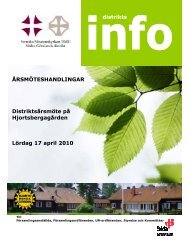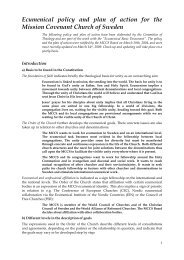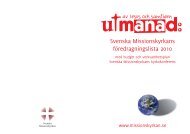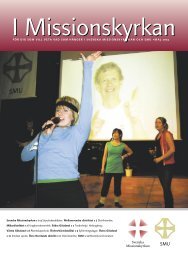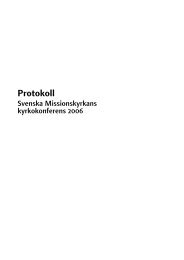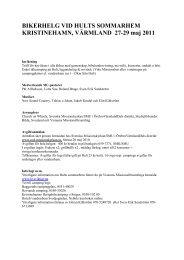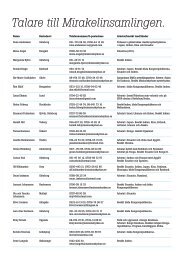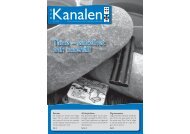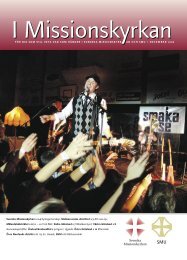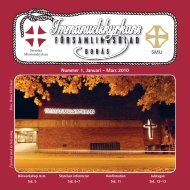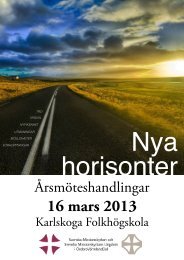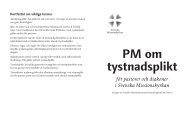Mission and Revolution in Central Asia - Svenska Missionskyrkan
Mission and Revolution in Central Asia - Svenska Missionskyrkan
Mission and Revolution in Central Asia - Svenska Missionskyrkan
Create successful ePaper yourself
Turn your PDF publications into a flip-book with our unique Google optimized e-Paper software.
missionaries tried to reach the Ch<strong>in</strong>ese through the ord<strong>in</strong>ary Muslim mission. This however<br />
proved impossible. The Ch<strong>in</strong>ese differed from the Muslims <strong>in</strong> so many ways: language,<br />
customs, outlook on life, religion <strong>and</strong> so on. The only way of reach<strong>in</strong>g the Ch<strong>in</strong>ese <strong>in</strong> a proper<br />
way was to start a special branch of work, among them. This <strong>Mission</strong> branch was to follow its<br />
own policy. 68<br />
With the arrival of Albert Andersson <strong>in</strong> the field, at the turn of the century, the Ch<strong>in</strong>ese<br />
<strong>Mission</strong> was <strong>in</strong>itiated. Mr <strong>and</strong> Mrs Andersson had previously worked as missionaries <strong>in</strong><br />
Northern Ch<strong>in</strong>a, where they had served the Christian <strong>Mission</strong>ary Alliance, also called the<br />
Franson <strong>Mission</strong> Society. 69 They therefore knew the language <strong>and</strong> were well acqua<strong>in</strong>ted with<br />
Ch<strong>in</strong>ese conditions. While on furlough <strong>in</strong> Sweden they were called upon by the MCCS to<br />
come <strong>and</strong> serve as missionaries to the Ch<strong>in</strong>ese <strong>in</strong> Eastern Turkestan. Andersson was no<br />
stranger to the MCCS. At the end of the 1880s he had studied at the MCCS <strong>Mission</strong> School,<br />
<strong>and</strong> after that served for some time as a pastor <strong>in</strong> the MCCS congregation of Skövde. 70<br />
Concurrently with the expansion of the Ch<strong>in</strong>ese branch of the <strong>Mission</strong> a stormy chapter of<br />
the Eastern Turkestan <strong>Mission</strong> opens. This was especially clear after the arrival of John<br />
Törnquist <strong>in</strong> the mission field <strong>in</strong> 1904. With the <strong>in</strong>troduction of the Ch<strong>in</strong>ese branch, the<br />
Eastern Turkestan <strong>Mission</strong> acquired a peculiar structure. It turned <strong>in</strong>to two separate <strong>Mission</strong>s<br />
with a common adm<strong>in</strong>istration <strong>and</strong> common funds. All the conditions were present for a<br />
conflict, as the two <strong>Mission</strong>s, with the best of <strong>in</strong>tentions, developed <strong>in</strong> separate ways.<br />
All the missionaries agreed that mission work among the Ch<strong>in</strong>ese was necessary. After all,<br />
the Ch<strong>in</strong>ese were the master race hold<strong>in</strong>g all higher offices <strong>in</strong> the country. This <strong>in</strong> itself was a<br />
strong reason for work<strong>in</strong>g among the Ch<strong>in</strong>ese. But where mission methods were concerned,<br />
op<strong>in</strong>ions differed. Some missionaries wanted Ch<strong>in</strong>ese <strong>Mission</strong>, of a dist<strong>in</strong>ctive character,<br />
with<strong>in</strong> the Muslim <strong>Mission</strong>. Others were of the op<strong>in</strong>ion that the Ch<strong>in</strong>ese <strong>Mission</strong> had to<br />
follow its own policy <strong>and</strong> form a special branch. The former united around Högberg <strong>and</strong><br />
Raquette <strong>and</strong> the latter around Andersson <strong>and</strong> Törnquist.<br />
When f<strong>in</strong>ally the MCCS opted for a special Ch<strong>in</strong>ese branch, this <strong>Mission</strong> came to be the<br />
cause of much irritation <strong>and</strong> tension among the missionaries for a long time. The missionaries<br />
to the Muslims were of the op<strong>in</strong>ion that the extent of the Ch<strong>in</strong>ese <strong>Mission</strong> was not justifiable<br />
with regard taken to how few the Ch<strong>in</strong>ese were. And maybe they were right. It is quite<br />
possible that the MCCS gave priority to the Ch<strong>in</strong>ese <strong>Mission</strong>, <strong>and</strong> that <strong>in</strong> accordance with a<br />
general tendency at the time. Of course Waldenström’s visit to Ch<strong>in</strong>a <strong>in</strong> 1907 contributed to<br />
<strong>in</strong>creased mission efforts. In the same year, Högberg published a small booklet on Eastern<br />
Turkestan where he writes about the exceed<strong>in</strong>gly small number of Ch<strong>in</strong>ese with<strong>in</strong> the<br />
population:<br />
“The question of how many percent of the population are Ch<strong>in</strong>ese is of special <strong>in</strong>terest for us <strong>and</strong> for our<br />
<strong>Mission</strong>. However op<strong>in</strong>ions differ as to the number of Ch<strong>in</strong>ese here. The British Consul believes them to<br />
be 0,33 % of the population. One of our Christian Ch<strong>in</strong>ese brothers thought they were only ‘one <strong>in</strong> a<br />
thous<strong>and</strong>’. This seems however to be a very low estimate…<strong>in</strong> my op<strong>in</strong>ion, the Ch<strong>in</strong>ese ‘<strong>in</strong> the six cities’<br />
are more likely to be below than above the number of three percent of the population.” 71<br />
Shortly afterwards, the <strong>Mission</strong> Secretary Sjöholm sent a letter to Törnquist, referr<strong>in</strong>g to<br />
Högberg’s figures. Consider<strong>in</strong>g the fact that the number of Ch<strong>in</strong>ese <strong>in</strong> Eastern Turkestan was<br />
negligible, the Ch<strong>in</strong>ese <strong>Mission</strong> must be relegated to a second place <strong>in</strong> plann<strong>in</strong>g the work.<br />
Törnquist took offence <strong>and</strong> <strong>in</strong> a reply he po<strong>in</strong>ts out that <strong>in</strong> certa<strong>in</strong> parts of the country, the<br />
Ch<strong>in</strong>ese population was about 50 %. Accord<strong>in</strong>g to him Högberg’s figures were totally<br />
68 Törnquist, 1928, p. 447 f.<br />
69 Ohldén, 1906, p. 102.<br />
70 Lundahl, 1917, p. 544 f.<br />
71 Högberg, 1907, p. 14 f.<br />
11



